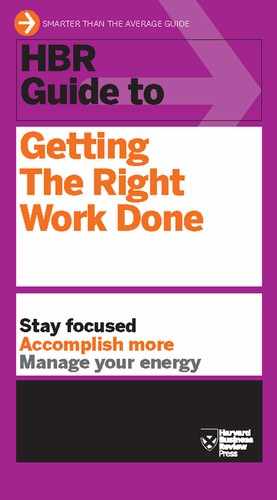Chapter 26
Sustaining Your Productivity System
by Alexandra Samuel
A productivity system is like any other faith: It works for as long as you continue to believe in it. Let a hint of skepticism creep in—about the discipline required, the rewards promised, or the potential superiority of other ideologies—and the threat of disorder quickly returns.
If you can accept that your system is a work in progress, it’s a lot easier to keep that threat at bay. Here are some tips for sustaining your productivity system:
- Focus on outcomes. Many productivity methodologies are so specific about their recommended processes that your zeal for maintaining your folders, sorting your communications, or acquiring snazzy storage bins can easily eclipse the problems or benefits that motivated you in the first place. Remember that adherence to a system is a false god: Don’t stick to it just because you bought the book or the software. If you’re working effectively and meeting your deadlines, it doesn’t matter if you no longer geocode your task list.
- Make micro commitments. When you embrace a new productivity religion, adopt its minor practices as well as its major ones. Sometimes the smaller commitments are the most sustainable. For example, two years after I got serious about In-box Zero, I no longer process my in-box to empty every day. But my e-mail is still dramatically easier to manage, thanks to the various filters I initially set up as part of my in-box zero approach.
- Find fellow adherents. One of my big stumbling blocks with David Allen’s book Getting Things Done was Allen’s denunciation of hanging folders; my file cabinet only worked with hanging files. Happily, I thought to Google “GTD hanging files,” and discovered a community of enthusiasts discussing the merits of various folder styles—and even brands—with the seriousness of Talmudic scholars. Reading about how other people implemented and adjusted the system liberated me from my slavish adherence to every detail. You can also make your own adherents: Marnie Webb, the CEO of nonprofit tech resource CompuMentor/ TechSoup, keeps a shelf full of copies of Getting Things Done. “When one of my team members complains about not being able to manage their lists or having too much to do, I pull a book off my shelf,” Webb says. “I tell them to complain again after they’ve implemented [GTD] for three months.”
- Schedule routine maintenance.A few years ago I sorted all the junk in our home office into beautifully labeled boxes. Six months later, a friend observed that whether you opened a box labeled “Bills to Pay” or “Pens and Highlighters,” you were guaranteed to find a pad of Post-its, an iPod adapter, a handful of batteries, and 37 cents in change. Now I know that getting organized isn’t enough—to stay organized, I have to set aside a couple of days every 4–6 months so that I can reestablish order and update my systems. (This is one of my favorite ways to make productive use of the few days after a major trip or project wrap-up, when I’m too brain-dead to do anything more demanding.)
- Anticipate obsolescence. Even the best productivity systems and tips may not survive the passage of time and the advent of new technologies. So stick with software tools that provide options for exporting your data to .csv, iCal, or other standard formats, so you don’t get trapped by any one platform.
- Embrace eclecticism. Troy Angrignon, vice president of sales and marketing at Cloudscaling, is religious about tracking his tasks and goals using a single, two-column document whose structure borrows from just about every productivity guru out there—Brian Tracy, David Allen, Robert Fritz. While combining approaches might amount to apostasy in the eyes of any one system’s adherents, it’s allowed Angrignon to develop a customized method that’s served him well for 15 years, even as he continues to make adjustments and sample new tools. You may also find that tweaking your productivity system, whether it’s trying out a new calendaring approach or sorting your paper files, is part of your creative process—a way of preparing yourself for a new year or project.
____________
Alexandra Samuel is the Director of the Social + Interactive Media Centre at Emily Carr University, and the co-founder of Social Signal, a Vancouver-based social media agency. You can follow Alex on Twitter at @awsamuel or her blog at alexandrasamuel.com.
..................Content has been hidden....................
You can't read the all page of ebook, please click here login for view all page.
